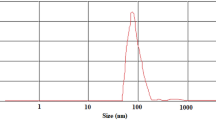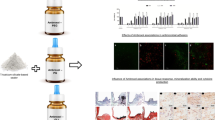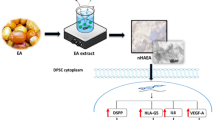Abstract
Objectives
The objectives of this study were to assess the effects of hyaluronic acid (HY), multi-walled carbon nanotubes (MWCNT), and MWCNT functionalized with HY (HY-MWCNT) on the resolution of neutrophilic inflammation in the pleural cavity of LPS-challenged mice and to assess the influence of these materials in the inflammatory process of bone repair of tooth sockets of rats.
Materials and methods
C57Bl/6 mice were intra-pleurally injected with HY, MWCNT, HY-MWCNT, phosphate-buffered saline (PBS), or LPS. The animals were euthanized after 8 and 24 h, and cells were harvested for total and differential cell counting. The tooth sockets of Wistar rats were filled with HY, MWCNT, HY-MWCNT, or blood clot (control). After 1, 3, and 7 days, histological and morphometric analyses evaluated the number of cell nuclei and blood vessels, and bone trabeculae formation in the sockets. Myeloperoxidase (MPO) activity quantified neutrophil accumulation in the sockets.
Results
HY, MWCNT, and HY-MWCNT increased neutrophilic recruitment at 8 h and reduced the inflammatory process at 24 h in the pleural cavity. Histological and morphometric analyses and MPO activity showed no significant differences in the recruitment of inflammatory cells in the tooth sockets. HY increased the number of blood vessels, and HY and HY-MWCNT increased bone trabeculae formation at 7 days of tooth extraction.
Conclusions
HY, MWCNT, and HY-MWCNT resolved the neutrophilic inflammation in the pleural cavity of the mice. However, these materials did not modulate the inflammatory process in the early stages of bone repair of the tooth sockets, thereby excluding this action as a possible mechanism by which these biomaterials accelerate bone repair.
Clinical relevance
HY-MWCNT is capable of accelerating bone repair/regeneration without affecting the inflammatory phase during the bone healing process.






Similar content being viewed by others
References
Lee HH, Sang Shin U, Lee JH, Kim HW (2011) Biomedical nanocomposites of poly(lactic acid) and calcium phosphate hybridized with modified carbon nanotubes for hard tissue implants. J Biomed Mater Res B Appl Biomater 98:246–254
Iijima S (1991) Helical microtubules of graphitic carbon. Nature 354:56–58
Bhattacharyya S, Guillot S, Dabboue H, Tranchant JF, Salvetat JP (2008) Carbon nanotubes as structural nanofibers for hyaluronic acid hydrogel scaffolds. Biomacromolecules 9:505–509
Bhattacharya M, Wutticharoenmongkol-Thitiwongsawet P, Hamamoto DT, Lee D, Cui T, Prasad HS, Ahmad M (2011) Bone formation on carbon nanotube composite. J Biomed Mater Res A 96:75–82
Liao CZ, Li K, Wong HM, Tong WY, Yeung KW, Tjong SC (2012) Novel polypropylene biocomposites reinforced with carbon nanotubes and hydroxyapatite nanorods for bone replacements. Mat Sci Eng C 33:1380–1388
Cheng Q, Rutledge K, Jabbarzadeh E (2013) Carbon nanotube-poly(lactide-co-glycolide) composite scaffolds for bone tissue engineering applications. Ann Biomed Eng 41:904–916
Martins-Júnior PA, Alcântara CE, Resende RR, Ferreira AJ (2013) Carbon nanotubes: directions and perspectives in oral regenerative medicine. J Dent Res 92:575–583
Zhao C, Tan A, Pastorin G, Ho HK (2013) Nanomaterial scaffolds for stem cell proliferation and differentiation in tissue engineering. Biotechnol Adv 31:654–668
Wisniewski HG, Hua JC, Poppers DM, Naime D, Vilcek J, Cronstein BN (1996) TNF/IL-1-inducible protein TSG-6 potentiates plasmin inhibition by inter-a-inhibitor and exerts a strong anti-inflammatory effect in vivo. J Immunol 156:1609–1615
Kobayashi H, Terao T (1997) Hyaluronic acid-specific regulation of cytokines by human uterine fibroblasts. Am J Physiol 273:C1151–1159
Ryman-Rasmussen JP, Tewskbury E, Moss OR, Cesta MF, Wong BA, Bonner JC (2009) Inhaled multiwalled carbon nanotubes potentiate airway fibrosis in a murine model of allergic asthma. Am J Respir Cell Mol Biol 40:349–358
Ryman-Rasmussen JP, Cesta MF, Brody AR, Shipley-Phillips JK, Everitt JI, Tewksbury EW, Moss OR, Wong BA, Dodd DE, Andersen ME, Bonner JC (2009) Inhaled carbon nanotubes reach the sub-pleural tissue in mice. Nat Nanotech 4:747–751
Mendes RM, Silva GA, Caliari MV, Silva EE, Ladeira LO, Ferreira AJ (2010) Effects of single wall carbon nanotubes and its functionalization with sodium hyaluronate on bone repair. Life Sci 87:215–222
Sá MA, Andrade VB, Mendes RM, Caliari MV, Ladeira LO, Silva EE, Silva GA, Corrêa-Júnior JD, Ferreira AJ (2013) Carbon nanotubes functionalized with sodium hyaluronate restore bone repair in diabetic rat sockets. Oral Dis 19:484–493
Einhorn TA, Majeska RJ, Rush EB, Levine PM, Horowitz MC (1995) The expression of cytokine activity by fracture callus. J Bone Miner Res 10:1272–1281
Mountziaris PM, Mikos AG (2008) Modulation of the inflammatory response for enhanced bone tissue regeneration. Tissue Eng Part B Rev 14:179–186
Schmidt-Bleek K, Schell H, Schulz N, Hoff P, Perka C, Buttgereit F, Volk HD, Lienau J, Duda GN (2012) Inflammatory phase of bone healing initiates the regenerative healing cascade. Cell Tissue Res 347:567–573
Fisher JP, Lalani Z, Bossano CM, Brey EM, Demian N, Johnston CM, Dean D, Jansen JA, Wong ME, Mikos AG (2004) Effect of biomaterial properties on bone healing in a rabbit tooth extraction socket model. J Biomed Mater Res A 68:428–438
Trigueiro JPC, Silva GG, Lavall RL, Furtado CA, Oliveira S, Ferlauto AS, Lacerda RG, Ladeira LO, Liu JW, Frost RL, George GA (2007) Purity evaluation of carbon nanotube materials by thermogravimetric, TEM, and SEM methods. J Nanosci Nanotechnol 7:3477–3486
Sousa LP, Lopes F, Silva DM, Tavares LP, Vieira AT, Rezende BM, Carmo AF, Russo RC, Garcia CC, Bonjardim CA, Alessandri AL, Rossi AG, Pinho V, Teixeira MM (2010) PDE4 inhibition drives resolution of neutrophilic inflammation by inducing apoptosis in a PKA-PI3K/Akt-dependent and NF-kappaB-independent manner. J Leukoc Biol 87:895–904
Caliari MV (1997) Princípios Básicos de Morfometria Digital: KS300 para iniciantes. UFMG, Belo Horizonte
Maltos KL, Menezes GB, Caliari MV, Rocha OA, Santos JM, Alves DL, Duarte ID, Francischi JN (2004) Vascular and cellular responses to pro-inflammatory stimuli in rat dental pulp. Arch Oral Biol 49:443–450
Souza DG, Cara DC, Cassali GD, Coutinho SF, Silveira MR, Andrade SP, Poole SP, Teixeira MM (2000) Effects of the PAF receptor antagonist UK74505 on local and remote reperfusion injuries following ischaemia of the superior mesenteric artery in the rat. Br J Pharmacol 131:1800–1808
Barcelos LS, Talvani A, Teixeira AS, Vieira LQ, Cassali GD, Andrade SP, Teixeira MM (2005) Impaired inflammatory angiogenesis, but not leukocyte influx, in mice lacking TNFR1. J Leukoc Biol 78:352–358
Queiroz-Junior CM, Pacheco CM, Fonseca AH, Klein A, Caliari MV, de Francischi JN (2009) Myeloperoxidase content is a marker of systemic inflammation in a chronic condition: the example given by the periodontal disease in rats. Mediators Inflamm 2009:760837
Petrey AC, de la Motte CA (2014) Hyaluronan, a crucial regulator of inflammation. Front Immunol 5:101
Liu L, Thompson AY, Heidaran MA, Poser JW, Spiro RC (1999) An osteoconductive collagen/hyaluronate matrix for bone regeneration. Biomaterials 20:1097–1108
Dechert TA, Ducale AE, Ward SI, Yager DR (2006) Hyaluronan in human acute and chronic dermal wounds. Wound Repair Regen 14:252–258
Mendes RM, Silva GA, Lima MF, Calliari MV, Almeida AP, Alves JB, Ferreira AJ (2008) Sodium hyaluronate accelerates the healing process in tooth sockets of rats. Arch Oral Biol 53:1155–1162
Stenson WF (2010) Hyaluronic acid and intestinal inflammation. Curr Opin Gastroenterol 26:85–87
Jain S, Thakare VS, Das M, Godugu C, Jain AK, Mathur R, Chuttani K, Mishra AK (2011) Toxicity of multiwalled carbon nanotubes with end defects critically depends on their functionalization density. Chem Res Toxicol 24:2028–2039
Usui Y, Aoki K, Narita N, Murakami N, Nakamura I, Nakamura K, Ishigaki N, Yamazaki H, Horiuchi H, Kato H, Taruta S, Kim YA, Endo M, Saito N (2008) Carbon nanotubes with high bone-tissue compatibility and bone-formation acceleration effects. Small 4:240–246
Lin C, Wang Y, Lai Y, Yang W, Jiao F, Zhang H, Ye S, Zhang Q (2011) Incorporation of carboxylation multiwalled carbon nanotubes into biodegradable poly(lactic-co-glycolic acid) for bone tissue engineering. Colloids Surf B: Biointerfaces 83:367–375
Ogihara N, Usui Y, Aoki K, Shimizu M, Narita N, Hara K, Nakamura K, Ishigaki N, Takanashi S, Okamoto M, Kato H, Haniu H, Ogiwara N, Nakayama N, Taruta S, Saito N (2012) Biocompatibility and bone tissue compatibility of alumina ceramics reinforced with carbon nanotubes. Nanomedicine (Lond) 7:981–993
Giavaresi G, Torricelli P, Fornasari PM, Giardino R, Barbucci R, Leone G (2005) Blood vessel formation after soft-tissue implantation of hyaluronan-based hydrogel supplemented with copper ions. Biomaterials 26:3001–3008
Carollo M, Hogaboam CM, Kunkel SL, Delaney S, Christie MI, Perretti M (2001) Analysis of the temporal expression of chemokines and chemokine receptors during experimental granulomatous inflammation: role and expression of MIP-1alpha and MCP-1. Br J Pharmacol 134:1166–1179
Mullane KM, Kraemer R, Smith B (1985) Myeloperoxidase activity as a quantitative assessment of neutrophil infiltration into ischemic myocardium. J Pharmacol Methods 14:157–167
Wei PF, Ho KY, Ho YP, Wu YM, Yang YH, Tsai CC (2004) The investigation of glutathione peroxidase, lactoferrin, myeloperoxidase and interleukin-1β in gingival crevicular fluid: implications for oxidative stress in human periodontal diseases. J Periodontal Res 39:287–293
David-Raoudi M, Tranchepain F, Deschrevel B, Vincent JC, Bogdanowicz P, Boumediene K, Pujol JP (2008) Differential effects of hyaluronan and its fragments on fibroblasts: relation to wound healing. Wound Repair Regen 16:274–287
Pasquinelli G, Orrico C, Foroni L, Bonafè F, Carboni M, Guarnieri C, Raimondo S, Penna C, Geuna S, Pagliaro P, Freyrie A, Stella A, Caldarera CM, Muscari C (2008) Mesenchymal stem cell interaction with a non-woven hyaluronan-based scaffold suitable for tissue repair. J Anat 213:520–530
Zhao B, Hu H, Mandal SK, Haddon RC (2005) A bone mimic based on the self assembly of hydroxyapatite on chemically functionalized single-walled carbon nanotubes. Chem Mat 17:3235–3241
Silva EE, Colleta HMH, Ferlauto AS, Moreira RL, Resende RR, Oliveira S, Kitten GT, Lacerda RG, Ladeira LO (2009) Nanostructured 3-d collagen/nanotube biocomposites for future bone regeneration scaffolds. Nano Res 2:462–473
Acknowledgments
This study was supported in part by Fundação de Amparo à Pesquisa de Minas Gerais (FAPEMIG), Conselho Nacional de Desenvolvimento Científico e Tecnológico (CNPq), and Coordenação de Aperfeiçoamento de Pessoal de Nível Superior (CAPES).
The manuscript does not contain clinical studies or patient data.
Author information
Authors and Affiliations
Corresponding author
Ethics declarations
Conflict of interest
The authors declare that they have no competing interests.
Rights and permissions
About this article
Cite this article
Martins-Júnior, P.A., Sá, M.A., Reis, A.C. et al. Evaluation of carbon nanotubes functionalized with sodium hyaluronate in the inflammatory processes for oral regenerative medicine applications. Clin Oral Invest 20, 1607–1616 (2016). https://doi.org/10.1007/s00784-015-1639-5
Received:
Accepted:
Published:
Issue Date:
DOI: https://doi.org/10.1007/s00784-015-1639-5




